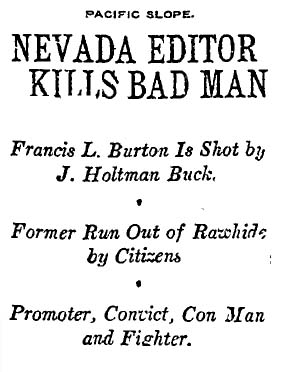 Dec. 10,1907
Dec. 10,1907
Los Angeles
Mayor Arthur C. Harper happens to be in all sorts of trouble. He’s telling the newspapers that he has had enough of politics and won’t seek another term. The district attorney is trying to shut down the local red light district and eventually these efforts will reveal allegations of City Hall corruption involving Harper, Police Chief Kern, a police commissioner, a police captain named Broadwood and Nicholas D. “Nick” Oswald, one of the biggest leaders of the city’s underworld.
 The 1909 Broadwood case is complicated (he was found not guilty, by the way, despite accounts of payoffs from the earnings of Los Angeles bordellos) and in researching the mayor’s life, I came across the following incident.
The 1909 Broadwood case is complicated (he was found not guilty, by the way, despite accounts of payoffs from the earnings of Los Angeles bordellos) and in researching the mayor’s life, I came across the following incident.
The word “homosexual” is a rarity in The Times, appearing exactly twice in editorial content between 1900 and 1940: a 1912 review of “The Candle and the Flame” by George Sylvester Viereck; and a 1939 health column by Dr. William Brady.
So what does the paper do when “purity squad” raids the former mayor’s home, 1128 W. 28th St.? Like this, from Feb. 1, 1920:
“Twenty Los Angeles men, some said to be prominent in social and business circles, were arrested last night by police at a stag party in the home of former Mayor Harper and were booked at the police station on the charge of social vagrancy.
“Seven of the men, including the host, Joseph Harper, 24 years old, are alleged by the officers making the raid to have been gowned in feminine apparel.”
After a few paragraphs, the paper says: “According to Police Sergeant Gifford and the officers of the ‘purity squad’ who conducted the raid, a degenerate orgy was in progress when they entered the house.”
The men were taken to jail as they were dressed, meaning that some of them spent the night in women’s clothing. Early the next morning, The Times says, the dresses were taken into evidence, so some of the men were given bathrobes and others draped themselves with jail blankets. Of the 16 arrested, four were released to the Navy (they were in uniform, The Times said) and eight were held in custody because they tested positive “for infectious disease.” And yes, their names or pseudonyms, addresses and occupations were published.
When asked about his son Joe, the former mayor said: “The only party he has given lately that I know of was given by him on Halloween night. His mother was present that night and among the guests during the evening, so I know nothing wrong took place.”
One of the sailors said: “I came in for my liberty and met a fellow at a downtown street corner. He asked me if I’d like to attend a nice party with dancing and girls and refreshments and said for me to bring some of my friends along.”
The Times said: “The sailors declare they did not know for a long time that the ‘girls’ were men and when they did learn of the fact, some thought it was just a good-natured masquerade ‘stunt.’ ”
 A later story says: “All the men are charged with lewd and dissolute conduct. Seven were dressed as women and the police say their acts were such that the charges against them can be upheld in court.”
A later story says: “All the men are charged with lewd and dissolute conduct. Seven were dressed as women and the police say their acts were such that the charges against them can be upheld in court.”
Police said that officers learned about the party several weeks ago. “Arrangements were made to have some of the officers in the house,” The Times said.
“The raiding officers in plain clothes gained entrance to the house and mixed with the strange guests. Several other officers climbed into the house by way of a rear window and concealed themselves beneath beds. After watching the ‘party’ for over two hours, whistles were blown and the raiding party rushed into the residence.”
Two months later, the case against the "Lady Men" was dismissed.
Bonus fact: One of the earliest occurrences of “gay bar” in The Times appears in a Oct. 15, 1953, story about the extortion trial of Jimmie Tarantino and refers to a bar on Market Street in San Francisco.
Lmharnisch.com
Lmharnisch.blogspot.com
e-mail: lmharnisch (AT) gmail.comLabels: 1907, 1909, 1912, Black Dahlia, Books and authors, City Hall, Crime and Courts, Downtown, LAPD, Streetcars
 Dec. 16, 1907
Dec. 16, 1907















